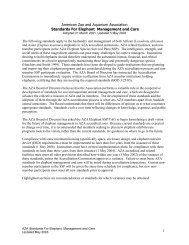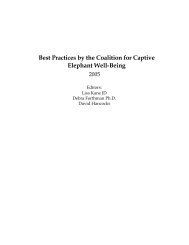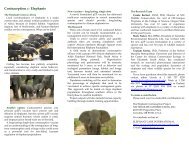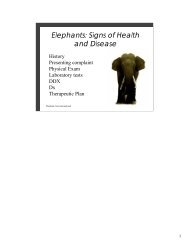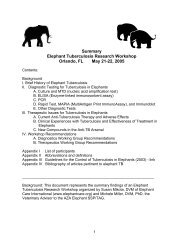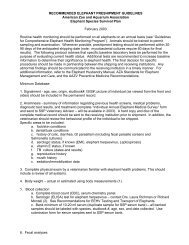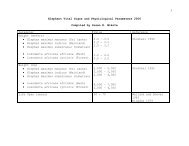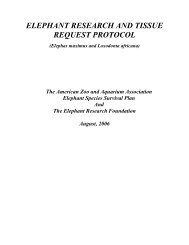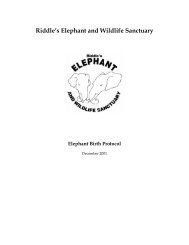Nepal Elephant TB Control and Mgt Action Plan.pdf - Elephant Care ...
Nepal Elephant TB Control and Mgt Action Plan.pdf - Elephant Care ...
Nepal Elephant TB Control and Mgt Action Plan.pdf - Elephant Care ...
- No tags were found...
Create successful ePaper yourself
Turn your PDF publications into a flip-book with our unique Google optimized e-Paper software.
DefinitionsAtypical mycobacteria: see non-tuberculous mycobacteriaCulture posi!ve for M. tb complex: Isola!on <strong>and</strong> iden!fica!on of M. tuberculosis complex organismsfrom any body site using st<strong>and</strong>ard mycobacterial methods.Culture posi!ve (M. tb complex) elephant: An elephant from which a M. tuberculosis complex organismhas been isolated. A culture posi!ve elephant is considered posi!ve un!l it has met the treatmentrequirements as outlined in this document.Dual Path Pla"orm (DPP) Vet ® <strong>TB</strong> test: A field test used to confirm <strong>Elephant</strong> <strong>TB</strong> Stat-Pak ® test results.The DPP Vet ® <strong>TB</strong> test detects an!bodies to specific <strong>TB</strong> an!gens. <strong>Elephant</strong>s that are reac!ve on the <strong>Elephant</strong><strong>TB</strong> Stat-Pak ® <strong>and</strong> react on line 2 or lines 1 <strong>and</strong> 2 of the DPP Vet ® <strong>TB</strong> test are considered <strong>TB</strong>-infectedbased on current scien!fic data (Greenwald et al. 2009). Infected elephants may or may not be shedding<strong>TB</strong> at the !me of tes!ng. The test was developed by Chembio Diagnos!c Systems Inc (Medford, NY, USA).<strong>Elephant</strong> <strong>TB</strong> Stat-Pak ® test: A qualita!ve screening test for <strong>TB</strong> in elephants which detects an!bodies toM. tuberculosis <strong>and</strong> M. bovis in elephant sera, plasma or whole blood. During development, the Stat-Pakwas referred to as the “RT” or “Rapid Test.” The <strong>Elephant</strong> <strong>TB</strong> Stat-Pak ® test is a USDA-approved product.(See Lyashchenko et al. 2005, Lyashchenko et al. 2006, Greenwald et al. 2009).Exposed: An elephant that 1) has had direct contact (touching or shared air space) with a known <strong>TB</strong>infectedelephant or human or 2) that has been kept in a stall adjacent to an infected elephant or which3) has had any other close associa!on with an infected elephant or human.Genotyping assay: A technique for the iden!fica!on <strong>and</strong> analysis of polymorphism in certain types ofrepeat units in DNA. Restric!on fragment length polymorphism (RFLP) <strong>and</strong> variable number t<strong>and</strong>emrepeat (VNTR) are examples of genotyping techniques.Incidence: The rate at which a certain event occurs, for example, the number of new cases of a specificdisease occurring during a certain period.Herd: A group of elephants maintained on common ground. Alterna!vely, two or more groups of animalsunder common ownership or supervision that are geographically separated, but that may have aninterchange or movement of animals or personnel (such as elephants owned by DNPWC).Loop-mediated isothermal amplifica!on (LAMP): A nucleic acid amplifica!on assay that has been usedto detect <strong>TB</strong> in human pa!ents in <strong>Nepal</strong> (P<strong>and</strong>ey et al. 2008).




